Top Causes of High Employee Turnover and How to Fix Them
Last Updated Nov 4, 2025

The email hit at 9:07 AM.
Another top performer — gone. No drama, no warning. Just a short note thanking the team and outlining a two-week notice.
As HR, you've seen this before, but that doesn’t make it easier. Especially when it keeps happening.
Resignations like this chip away at more than just headcount. They leave teams stretched thin, drive up recruiting costs, and send a message that something isn’t quite right under the surface. When exits become routine, it’s a clear sign of deeper cultural cracks.
HR leaders sit at the center of this challenge. To keep great people, you have to know why they’re leaving. That means digging into the root causes, tracking the patterns, and taking meaningful action before more inboxes light up with goodbye notes.
Uncover the most common reasons employees walk away, and what to do about it. Transform high turnover into a culture of retention that people don’t want to leave.
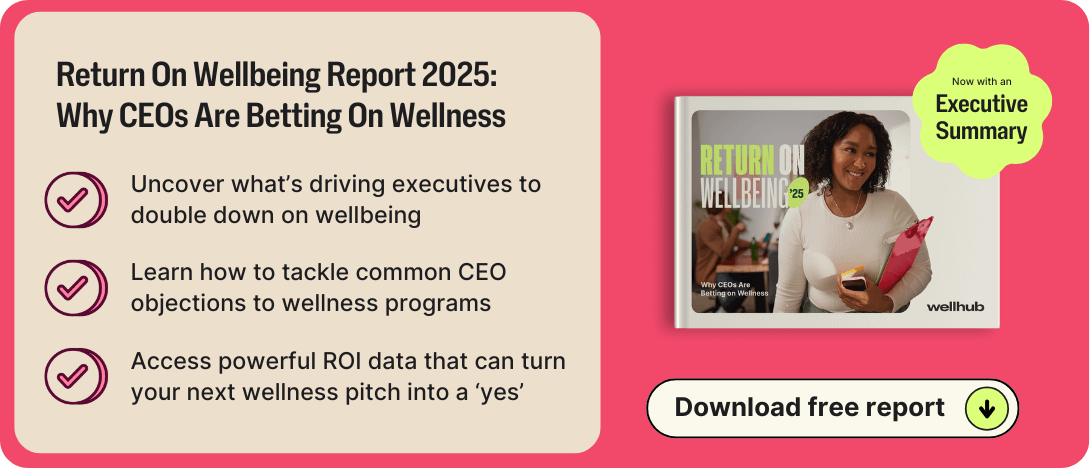
What You'll Learn
- Industry benchmarks for turnover rates vary widely — from as low as 1.3% in government jobs to over 20% in hospitals and retail-related sectors.
- High turnover often signals deeper organizational issues, such as low pay, poor leadership, limited growth opportunities, or toxic workplace culture.
- The costs of turnover extend beyond recruiting — it affects productivity, morale, institutional knowledge, reputation, and customer relationships.
- Common drivers of high turnover include inadequate compensation, lack of career development, weak onboarding, poor recognition, and burnout.
- How companies can reduce turnover by offering competitive pay and benefits, prioritizing employee development, supporting strong leadership, fostering psychological safety, and building an inclusive, engaging culture.
What is a High Turnover Rate? Employee Turnover Averages in the U.S.
What counts as a “high” turnover rate depends on the industry. The average turnover across all industries ranges from 1.9% and 2.2%, according to a 2025 BambooHR report, but that average can vary a lot depending on the specific industry. If your company's turnover rate is higher than industry benchmarks, then you have a high turnover rate.
Average Annual Turnover Rates of Major American Industries
| Industry | Turnover Rate (2025) |
|---|---|
| Government Jobs | 1.3% |
| Finance & Insurance | 1.6% |
| Information/Technology | 2.7% |
| Manufacturing | 2.7% |
| Construction | 3.9% |
| Private Education & Health Services | 3.4% |
| Professional & Business Services | 4.7% |
| Accommodation & Food Services | 5.2% |
| Transportation & Warehousing | 5.1% |
| Energy | 8.0% |
| Administrative/Waste Services | 15.0% |
| Public Education | 16.0% |
| Retail Trade | 19.3% |
| Grocery Stores/Supermarkets | 19.3% |
| Hospitals | 20.7% |
If your organization’s turnover rate is above your industry’s average, you need to start looking at the root causes. The longer it takes to address such issues, the more entrenched—and harder to fix—they become.
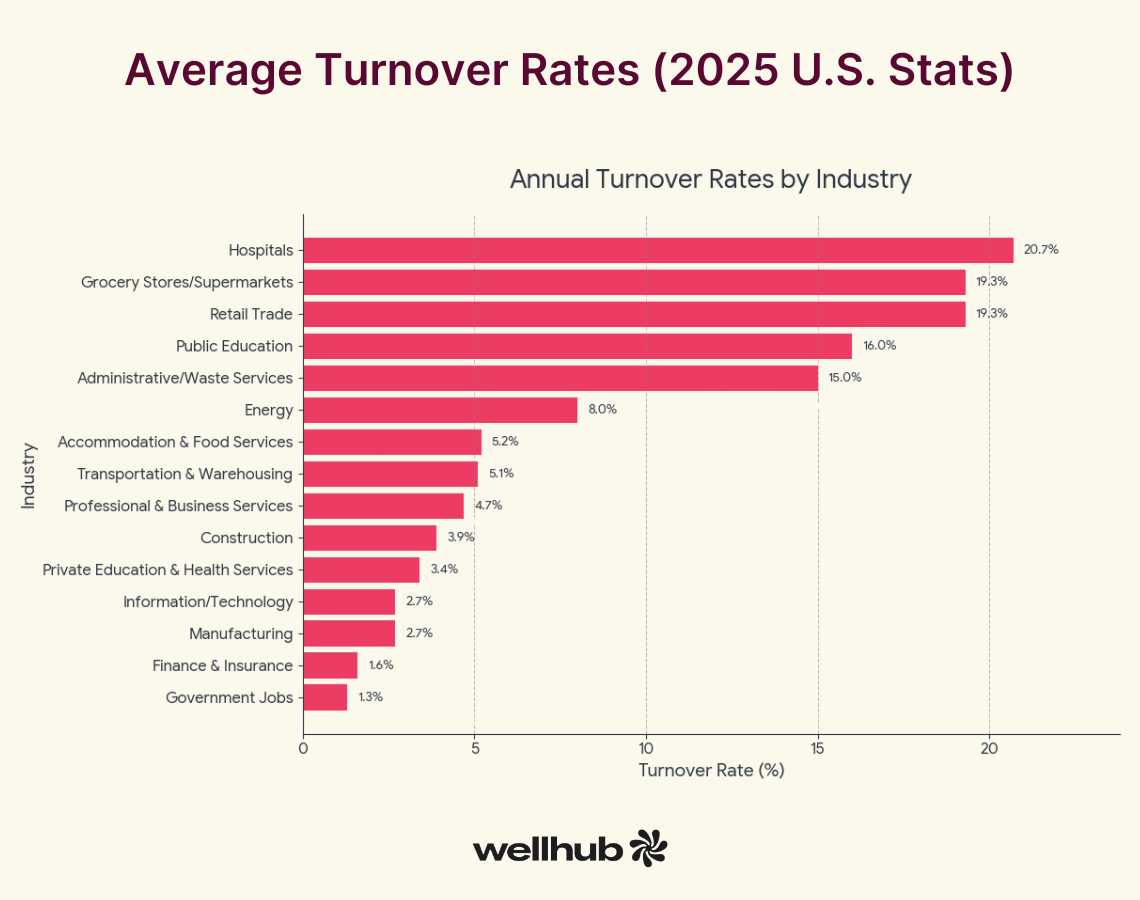
What Does a High Employee Turnover Mean?
Turnover is the rate at which employees leave a company. It’s a percentage of the workforce over a specified period, typically a year. Some turnover is natural, since people retire, relocate, or pursue career changes.
High turnover exceeds the expected level. This number is a critical symptom of underlying issues with compensation, leadership, career development, workplace culture, or workload balance that push people to leave. Common examples include employees feeling underpaid compared to their industry peers, being unsupported by managers who lack training or empathy, or being overwhelmed by a workload that leads to burnout.
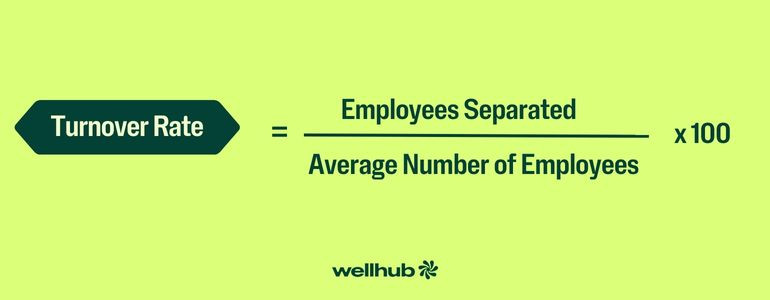
High turnover can be voluntary—when employees choose to leave for another opportunity—or involuntary, when organizations dismiss employees due to performance, restructuring, or other factors. Both cause long-term consequences, but voluntary turnover often reveals more foundational issues. It can reflect dissatisfaction with pay, leadership, career growth, or overall company culture.
For HR leaders, a persistently high employee turnover rate is a red flag. It suggests a misalignment between what employees need and what the organization is providing. Accordingly, they should do a deep dive into why they're seeing high turnover and how to start fixing the root causes of it.
The Negative Business Impacts of High Turnover
High turnover can cause a wide range of problems within your organization, including reduced productivity and morale, disrupted workflow, damage to the company's reputation, and increased instability. All of these can lead to a vicious cycle where remaining staff members take on heavier workloads, and the cycle of burnout repeats.
Here’s a breakdown of the main impacts of high turnover and how they limit your business.
Hidden Costs Associated With Turnover
Replacing an employee isn’t just time-consuming. It’s expensive. Think recruiting, interviewing, onboarding, training — all while productivity takes a hit. According to Gallup, replacing a single employee can cost from 50% to 200% of their salary, depending on their role.
These costs add up quickly. And when turnover happens regularly, they can quietly chip away at your profit margins.
Reduced Productivity and Morale
When someone leaves, their responsibilities fall to your remaining team. That means heavier workloads, more stress, and less time for strategic work. It also means losing institutional knowledge that’s hard to replace.
As this pressure builds, burnout becomes a real risk. Morale drops. Collaboration falters. And before you know it, turnover leads to… more turnover.
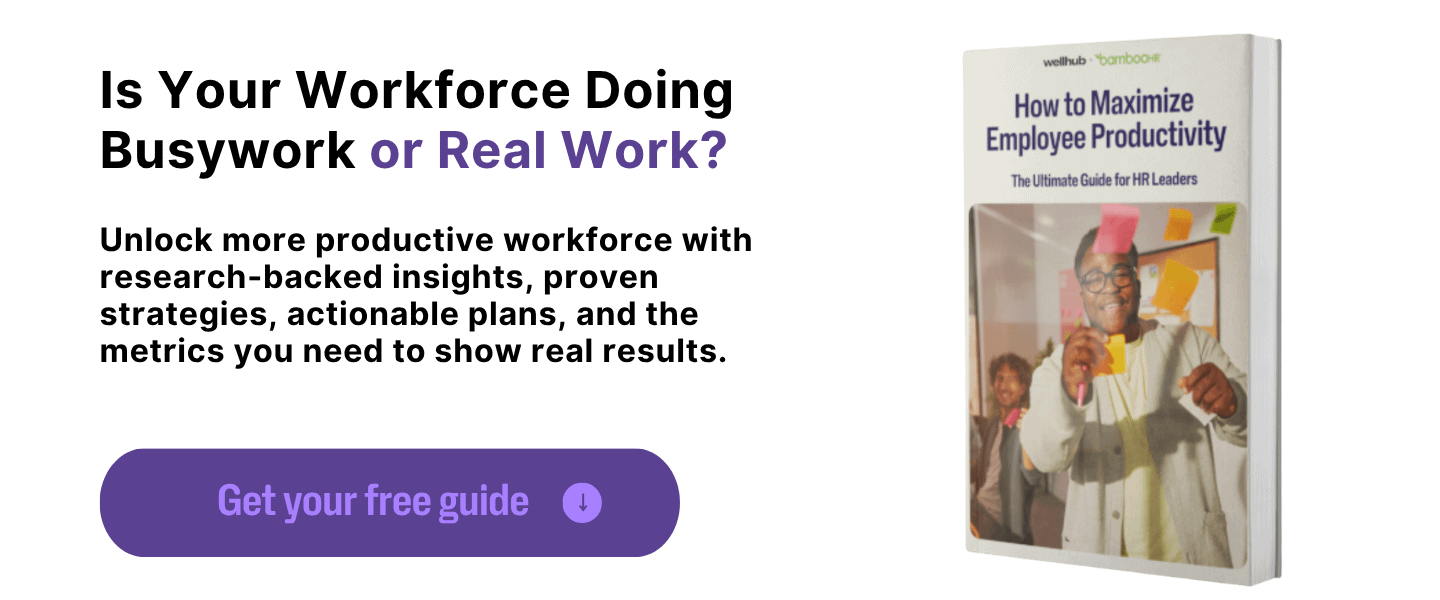
Damaged Company Reputation
In today’s hiring landscape, your employer brand is everything. Prospective candidates are checking your Glassdoor reviews, scanning your job boards, and noticing patterns. If roles are constantly reposted or reviews hint at internal instability, that’s a red flag.
And when talented professionals get the sense your company struggles to keep people? They may not apply in the first place.
Increased Instability
High turnover makes it harder to maintain consistent progress. Teams are always adjusting to new colleagues. Long-term projects stall. Institutional knowledge gets lost in transition.
When trust and rhythm are constantly disrupted, your team ends up reacting instead of strategizing. That leaves no room for innovation to thrive.
Institutional Knowledge Disappears
Every employee carries a wealth of knowledge about your systems, clients, internal workflows, and culture. When they leave, that knowledge walks out the door too. Even with documentation and handovers, it’s rarely a clean transfer. New hires take time to catch up. And if turnover keeps happening, you’re constantly starting from scratch.
Leadership Development Gets Derailed
You can’t grow strong leaders without consistency. When high-potential employees leave before being promoted, succession planning falls apart.
Suddenly, you’re scrambling to fill leadership gaps with external hires — which costs more, takes longer, and can damage morale if internal employees feel overlooked.
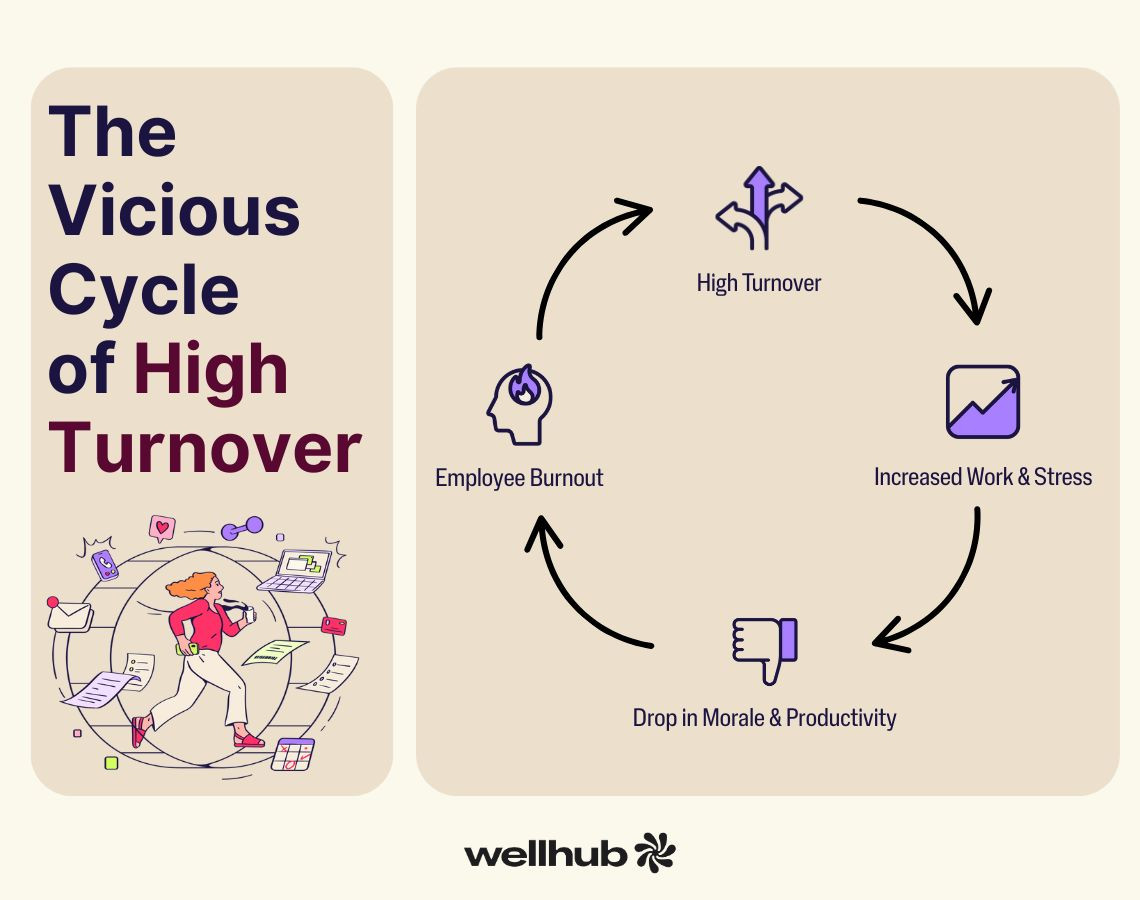
Engagement Metrics Drop
When teammates leave, those who stay often disengage. They wonder why their colleagues left. They worry they’ll be next. And they may stop going the extra mile, simply trying to survive the day-to-day. This disengagement shows up in your data — lower pulse survey scores, weaker performance reviews, and fewer referrals.
DEIB Progress Slows Down
Turnover doesn’t affect everyone equally. If you're seeing higher attrition rates among underrepresented groups, that’s a warning sign. It can undo years of DEIB progress and create a workplace that feels less inclusive over time. And if candidates from diverse backgrounds see a pattern of departures, they may self-select out — even before the first interview.
Not all turnover is the same.Find out which types matter most—and how to manage them strategically.
Customer Relationships Suffer
Employees don’t just work within your company — they represent it outside of it. When trusted team members leave, your customers feel the disruption too.
It can result in lost accounts, missed upsells, and reputational damage. Relationships take time to build, and they disappear fast if there’s no continuity.
Time-to-Productivity Increases
Even the best new hire can’t hit the ground running on Day 1. It takes weeks (sometimes months) to get up to speed, master workflows, and build relationships. If you’re constantly onboarding new employees, you’re constantly losing momentum. And that slows down progress on everything — from daily deliverables to quarterly OKRs.
Top Reasons for Employee Turnover
Turnover doesn’t happen in a vacuum. People leave when their needs go unmet, and those needs are changing fast. From compensation to culture, the reasons employees walk away often point to gaps in organizational support.
Let’s take a closer look at the most common drivers of turnover — and how you can address them before your best people start job hunting.
Low Compensation and Inadequate Benefits
Thanks to pay transparency laws and tools like Glassdoor, employees know what they’re worth. If your salaries fall short of market expectations, you risk losing top performers to competitors who are paying attention.
And it’s not just about the paycheck. Employees also look closely at benefits. Gaps in healthcare, minimal retirement matching, or limited PTO make even a good job feel unsustainable.
Today’s workforce wants flexibility, diversity, and inclusivity in their benefits, too. Think: mental health support, student loan repayment, fertility benefits, or access to on-demand wellbeing resources. When these aren’t available, talent acquisition slows — and retention suffers.
Lack of Employee Development
When employees can’t see a clear path forward, they start planning their exit.
In fact, career development issues were the #1 driver of voluntary turnover in 2024, according to the Work Institute. And for younger workers? Staying in one role too long can feel like standing still.
In a ResumeLab survey, 83% of Gen Z workers in the U.S. identified as “job hoppers,” eager to explore new challenges that better align with their values. They’re not afraid to leave — they’re excited to level up.
If you want to hold on to rising talent, invest in them. Upskilling programs, mentorship, tuition assistance, and internal mobility plans signal you’re committed to their growth.
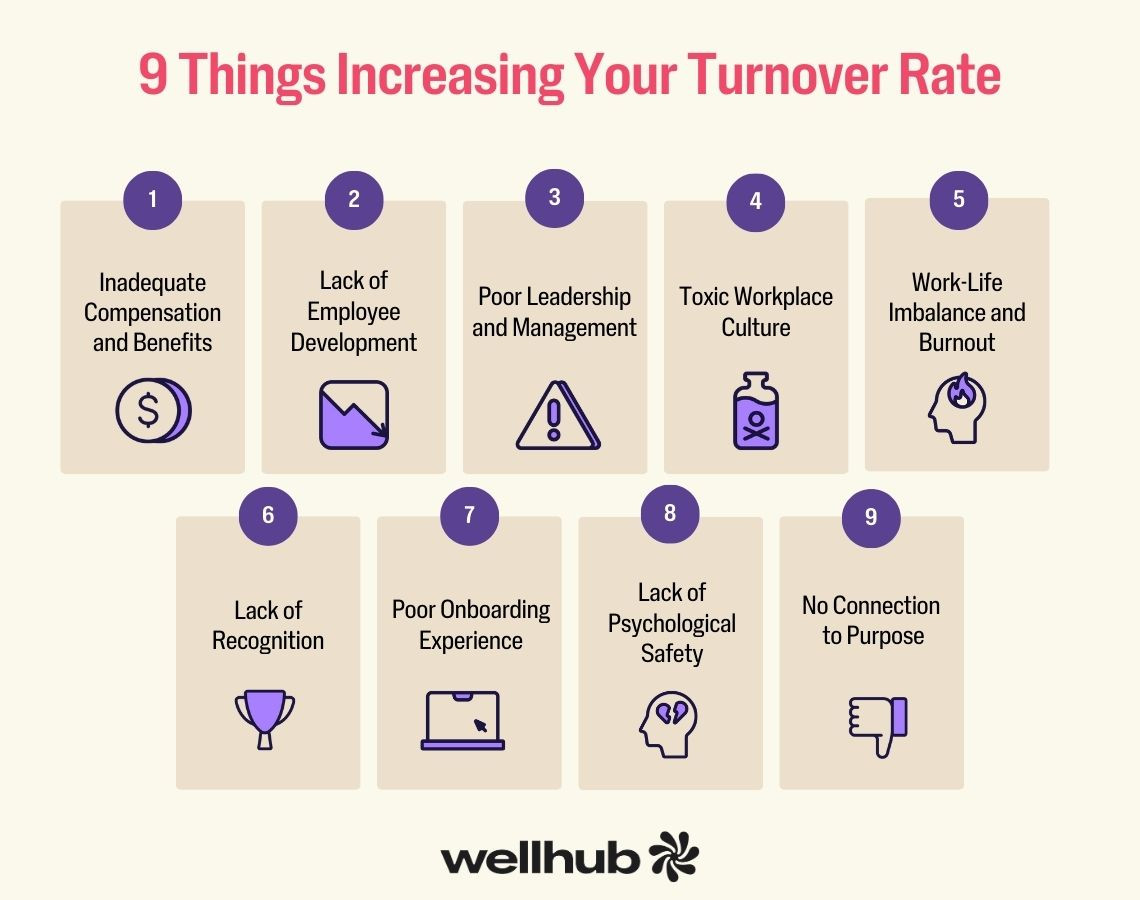
Poor Leadership and Management
You’ve heard it before: people don’t leave companies, they leave managers. And the data backs that up.
The 2025 SHRM State of the Workplace Report found poor leadership is one of the top causes of high turnover. Whether it’s micromanagement, lack of recognition, or unclear expectations, bad management leads to disengagement.
Only 42% of U.S. workers said their company was effective at leadership development in 2024. That’s a problem — and an opportunity. Training managers to lead with empathy, give effective feedback, and support employee wellbeing builds trust. And trust is the foundation of retention.
Toxic Workplace Culture
Culture is more than posters in the breakroom — it’s how your employees experience work every day.
When people feel excluded, unheard, or undervalued, they disengage. Signs of a toxic culture can include favoritism, lack of recognition, poor communication, and a failure to address conflict. Even when toxicity only touches part of the org, it impacts everyone.
On the flip side? A positive, inclusive culture boosts morale, improves motivation, and builds loyalty. Recognition programs, transparent communication, and DEIB initiatives are powerful tools to help your people feel connected and safe at work.
Work-Life Imbalance and Burnout
The boundary between work and life has never been blurrier. Slack messages after hours, weekend email catch-up, and nonstop deadlines make it hard to log off — and even harder to recharge.
Over time, this chronic stress leads to burnout. And burnout leads to turnover. The consequences go beyond disengagement. Burnout can trigger long-term health issues — from high blood pressure to depression — and create a cycle of absenteeism, presenteeism, and resignations.
Organizations that support employee wellbeing, such as offering flexible schedules, realistic workloads, and access to wellbeing tools, can break that cycle. When people feel supported, they stay.
Lack of Recognition
Employees want to know their work matters. When hard work goes unnoticed — or worse, taken for granted — people feel disconnected from their impact.
Recognition doesn’t have to be elaborate. But it does have to be consistent. A simple thank-you, a public shoutout, or a spot bonus can go a long way. Without it, motivation fades — and employees quietly start looking elsewhere.
Recognition programs don’t just improve morale. They’re directly linked to better retention, higher engagement, and stronger team performance.
8 proven strategies HR leaders are using to reduce turnover today.
Poor Onboarding Experience
First impressions matter. A lo:t: Up to 20% of turnover happens within the first 45 days of employment. That’s preventable.
When new hires aren’t properly welcomed, trained, or supported, it sets the tone for everything that follows. They may feel confused, disconnected, or overwhelmed — and begin to doubt their decision to join in the first place.
A structured, thoughtful onboarding process builds confidence, reinforces belonging, and gets people excited to contribute. It’s your first chance to show them what kind of culture they’ve joined.
Lack of Psychological Safety
When employees don’t feel safe to speak up — about ideas, mistakes, or concerns — they shut down. And when they shut down long enough? They move on.
Psychological safety fuels innovation, inclusion, and team connection. Without it, fear takes root. People worry about retribution, stay silent in meetings, and avoid collaboration.
Creating a culture of psychological safety starts with leadership. Encourage questions. Normalize feedback. Respond with empathy. That’s what helps employees feel seen — and stay.
No Connection to Purpose
People don’t just want a job. They want meaning.
When employees feel disconnected from your mission or unsure how their work contributes to the big picture, it’s easy to disengage. They might still meet deadlines — but they’re already mentally checked out.
Purpose is a powerful motivator. It boosts resilience, deepens engagement, and increases retention. The more you help employees connect their role to your company’s larger impact, the more likely they are to stick around and grow with you.
How to Lower Employee Turnover Rates by Boosting Retention
If turnover is the symptom, retention is the cure. The good news? You can start improving retention with a few strategic changes. Each challenge has a clear path forward — and every step you take toward better support helps your employees stay, grow, and thrive.
Let’s walk through how to address the most common causes of employee turnover with intention, compassion, and impact.
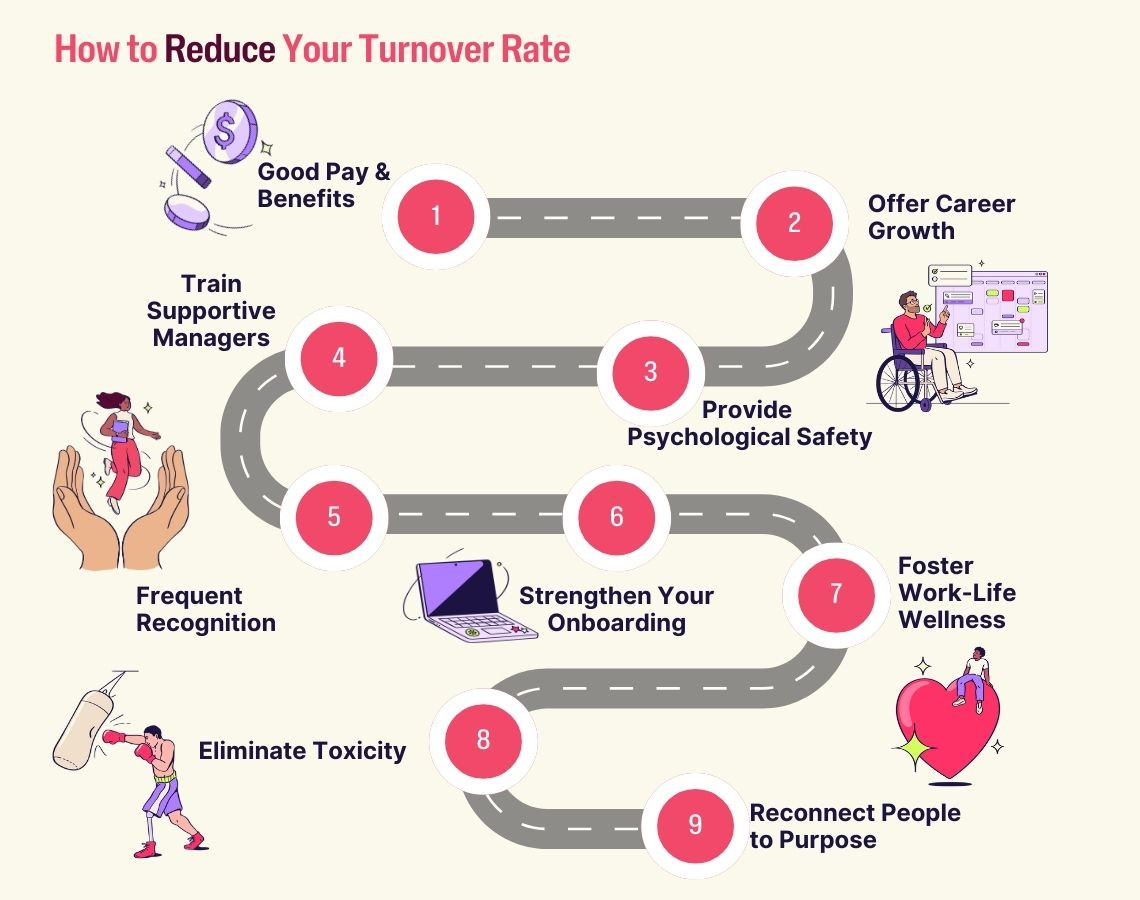
- Offer Competitive Pay and Meaningful Benefits
What to do: Start with market benchmarking. Ensure your compensation structure reflects your industry and region — and reevaluate it annually. But don’t stop at salaries. Build a benefits package that supports the whole employee: physical, mental, emotional, and financial health.
Action Steps:
- Conduct a total compensation audit each year
- Offer flexible benefits like mental health coverage, fertility care, or fitness stipends
- Include cost-effective, high-impact perks like hybrid work and PTO for volunteering
These benefits build a culture of care — and show your people they’re valued beyond their paycheck.
- Build Career Growth Into the Employee Journey
What to do: Create an employee development roadmap for every level of your organization. This means offering upskilling, coaching, and clear promotion paths — not just for leaders, but for everyone.
Action Steps:
- Launch internal mobility programs to make career pathways visible
- Budget for tuition reimbursement or online certifications
- Pair rising talent with mentors to foster connection and advancement
When people see a future with you, they’re far more likely to stay for the long haul.
- Train Managers to Be Supportive Leaders
What to do: Your managers are the bridge between company values and daily experience. And they need support too. Equip them with the tools to lead with empathy, accountability, and confidence.
Action Steps:
- Provide training on feedback, active listening, and conflict resolution
- Establish manager KPIs that include team engagement and retention
- Offer coaching for new and mid-level leaders
When leaders grow, teams thrive. It’s that simple.
- Prioritize Psychological Safety
What to do: Create space where employees feel safe to speak up, make mistakes, and share feedback without fear. Psychological safety doesn’t happen by accident — it’s built on trust and transparency.
Action Steps:
- Start team meetings with check-ins and space for questions
- Train managers on inclusive meeting facilitation
- Protect feedback channels and honor confidentiality
A safe team is an engaged team — and engaged teams don’t churn.
- Make Recognition a Daily Habit
What to do: Recognition is free, fast, and powerful — and yet it’s often overlooked. Regular acknowledgment strengthens connection and shows people that what they do matters.
Action Steps:
- Train managers to deliver in-the-moment praise
- Use digital platforms for peer-to-peer recognition
- Celebrate wins publicly — even small ones
When employees feel seen, they feel like they belong. And that’s worth staying for.
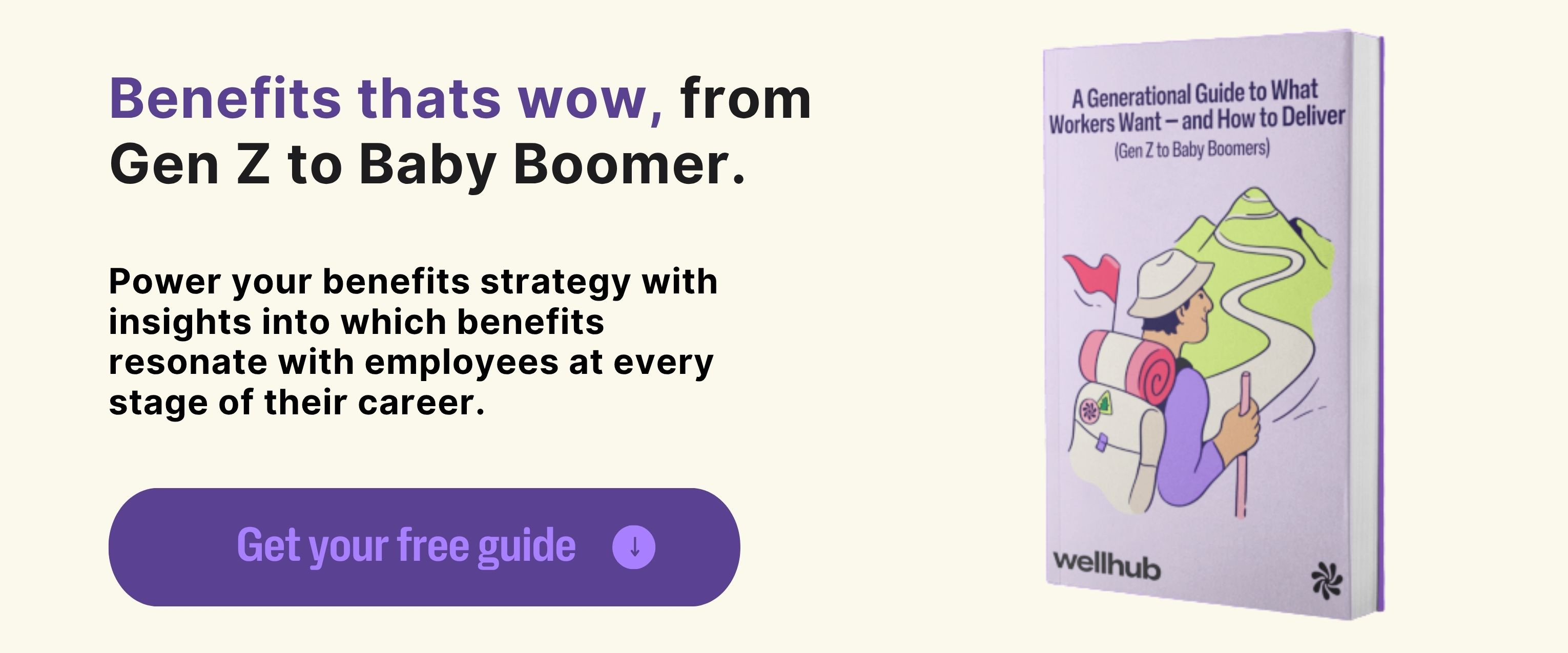
- Strengthen Onboarding From Day One
What to do: Your onboarding should not feel like a checklist. It should feel like an invitation. Design it to build confidence, connection, and purpose — and ensure every new hire understands how they contribute to the bigger picture.
Action Steps:
- Assign onboarding buddies to help new hires feel supported
- Include culture-building activities, not just compliance training
- Check in at 30-, 60-, and 90-day milestones to gather feedback
A great start leads to long-term engagement.
- Foster Work-Life Wellness
What to do: Help employees log off — really log off. When work stops spilling into personal time, energy and performance go up.
Action Steps:
- Set norms for communication outside of work hours
- Encourage PTO (and make sure leaders model it)
- Offer flexible schedules or compressed workweeks when possible
Burnout is preventable. But only if you design for balance.
Top talent won’t wait around. Get ahead of 2026’s retention challenges with data-driven solutions.
- Address Toxicity — and Act Fast
What to do: Culture isn’t what you say — it’s what people feel. If your teams are navigating favoritism, microaggressions, or unresolved conflict, it’s time to intervene. Quickly.
Action Steps:
- Empower HR to take anonymous reports seriously
- Offer DEIB and anti-harassment training company-wide
- Include culture-based questions in exit and stay interviews
When your culture reflects your values, people stay because they want to — not because they have to.
- Reconnect People to Purpose
What to do:Tie everyday work to your company’s mission. Employees want to know their time is creating impact — and they want to be part of something bigger than a to-do list.
Action Steps:
- Share customer stories or social impact results in team meetings
- Include purpose and values in onboarding and all-hands
- Let employees see the outcome of their contributions
People stay when their work feels meaningful. Make it easy for them to see the “why.”
Reduce High Turnover by Supporting Employee Wellbeing
High turnover signals deeper problems. Employees leave when they feel burned out, underappreciated, unsupported, or disconnected from their work: A full 83% of employees would consider leaving a company that does not focus on employee wellbeing.
These issues drive up costs, stall productivity, and damage culture.
A strong employee wellbeing program can change that. It shows employees their health and happiness matter — not just their output. Wellhub helps companies support physical, mental, and emotional wellbeing with flexible, personalized benefits. And it works: 74% of Wellhub members say their wellbeing improved over the last year compared 43% of non-members.
This is why companies see turnover drop by up to 43% with Wellhub. Speak with a Wellhub Wellbeing Specialist to lower turnover and create a workplace where people want to stay

Company healthcare costs drop by up to 35% with Wellhub*
See how we can help you reduce your healthcare spending.
Category
Share

The Wellhub Editorial Team empowers HR leaders to support worker wellbeing. Our original research, trend analyses, and helpful how-tos provide the tools they need to improve workforce wellness in today's fast-shifting professional landscape.
Subscribe
Our weekly newsletter is your source of education and inspiration to help you create a corporate wellness program that actually matters.
Subscribe
Our weekly newsletter is your source of education and inspiration to help you create a corporate wellness program that actually matters.
You May Also Like

Corporate Wellness Trends HR Must Know for 2026 | Wellhub
See the top 2026 wellness trends shaping performance, retention, and culture—plus how HR can build a unified, ROI-driven wellbeing strategy.

Wellness Points Programs: Boost Employee Health & Engagement | Wellhub
Turn your workplace wellness strategy around with a points program that rewards healthy behavior with perks, from extra time off to gift cards.

Employee Financial Wellness Programs: Ultimate HR Guide | Wellhub
Create an effective financial wellness program that supports your employees in their financial needs, boosting productivity and retention.